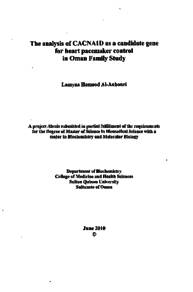Document
The analysis of CACNAID as a candidate gene for heart pacemaker control in Oman family study
Publisher
Sultan Qaboos University
Gregorian
2010
Language
English
Subject
English abstract
In the Oman Family Study (OFS), which started in 2002, 5 large, extended and highly consanguineous families were examined for anthropometric, metabolic and haemodynamic parameters. This project is a small part of the OFS as it includes continuing investigations by using different molecular and biochemical techniques. One of the families (family 4) was selected for this project since some of the family members show an abnormal ECG pattern with an irregularity in the heart rate (R-R interval) that has not been described before. Linkage analyses on these individuals have been performed and a signal with a LOD score of 3.184 was identified in the p21-p13 region of chromosome 3. After using bioinformatical tools, different genes were identified within this area and a candidate gene (CACNA1D) was selected. The CACNAID gene is a member of the Cayl family coding for a Voltage-dependent calcium channels aj subunit; Ca 1.3 which is contributing to pacemaker activity and its inactivation results in Sinoatrial node dysfunction (arrhythmia). Moreover, there have been several knockout studies of CACNAID performed in mice showing the importance of this gene for pacemaker function. In this project sequence analysis of the CACNAID gene was performed for 8 individuals in order to examine if any mutations that may affect the function of the Cav1.3 and thereby affect the pacemaker activity were present. 4 affected individuals from family 4 and 4 unaffected individuals within the OFS were chosen. The samples were screened by sequencing all 49 exons of the candidate gene. Overall, 46 exons were screened successfully while 3 were not analyzed because of difficulties during PCR optimizations. 11 SNPs were detected, and 3 of these were novel. 6 SNPs were found within exons and the remaining 5 were found within splicing regions. There are no publications linking any of the identified SNPs with functional changes of the Ca2+ channel. The three remaining exons need to be sequenced and the identified SNPs need to be confirmed before the CACNAID gene can be excluded as a candidate gene causing the irregularity in heart rhythm observed in the affected individuals in the OFS.
Member of
Resource URL
Arabic abstract
يسعى هذا المشروع للبحث عن إشارة معينة تساوي القياس اللوغاريثمي (LoD) وقيمته 3 . 184 في منطقة الصبغيات الوراثية ( p21 - 3p13 ) في الأشخاص الذين ينتمون لأحد العائلات المكونة لمشروع عائلة عمان الدراسية (Oman family Study)، حيث أن الأغلبية العظمى وجد لديهم نتيجة تخطيط القلب (ECG) غير طبيعية بالرغم من أن هؤلاء الأشخاص لا يشكون من أي مرض في القلب ولم تسجل لديهم أي حالة وفاة متعلقة بمرض في القلب ، وهي ظاهرة غريبة جدا لم يسبق وصفها أبدا، حيث أن معدل سرعة نبضات القلب في فترة معينة (R - interval R) كانت غير طبيعية تماما. لقد تم ترشيح جين معين (CACNA1D) يقع في الصيغة الجينية (الكروموسومية) رقم 3 (3 chromosome) والذي يتحكم بقناة الكالسيوم المعتمدة على القوة الكهربائية المقاسة بالفولتات ، حيث أن من المحتمل أن يكون هذا هو الجين المسؤول عن هذة الظاهرة الغريبة. يهدف هذا المشروع الدراسة إن كان هذا الجين هو المسؤول عن نبضات القلب غير طبيعية بالإضافة إلى الكشف عن أي طفرات وراثية في هذا الجين في الأشخاص الذين ينتمون للعائلة رقم 4 في مشروع عائلة عمان الدراسية تم فحص 8 عينات من ال DNA وتم تحليلها باستخدام التسلسل الوراثي (Sequencing) للتعرف فيما اذا كان هنالك طفرات بهذا الجين. نتيجة تحليل التسلسل الوراثي في 46 منطقة في الموروث CACNA1D تم ایجاد 11 تغيرات أحادية النيوكليوتيدات SNPs ، ثلاث منها تعتبر جديدة لم يتم التعرف عليها سابقا. و بالرغم من ذلك لا يمكن أن نستثني علاقة هذا الجين بتلك الظاهرة حيث أن ثلاث مناطق ف الجين لم يتم تحليلها بعد(1و11 و25 Exons) وتلك التغييرات SNPs تحتاج لاعادة التحليل والتأكيد من خلال زيادة عدد العينات.
Category
Theses and Dissertations

